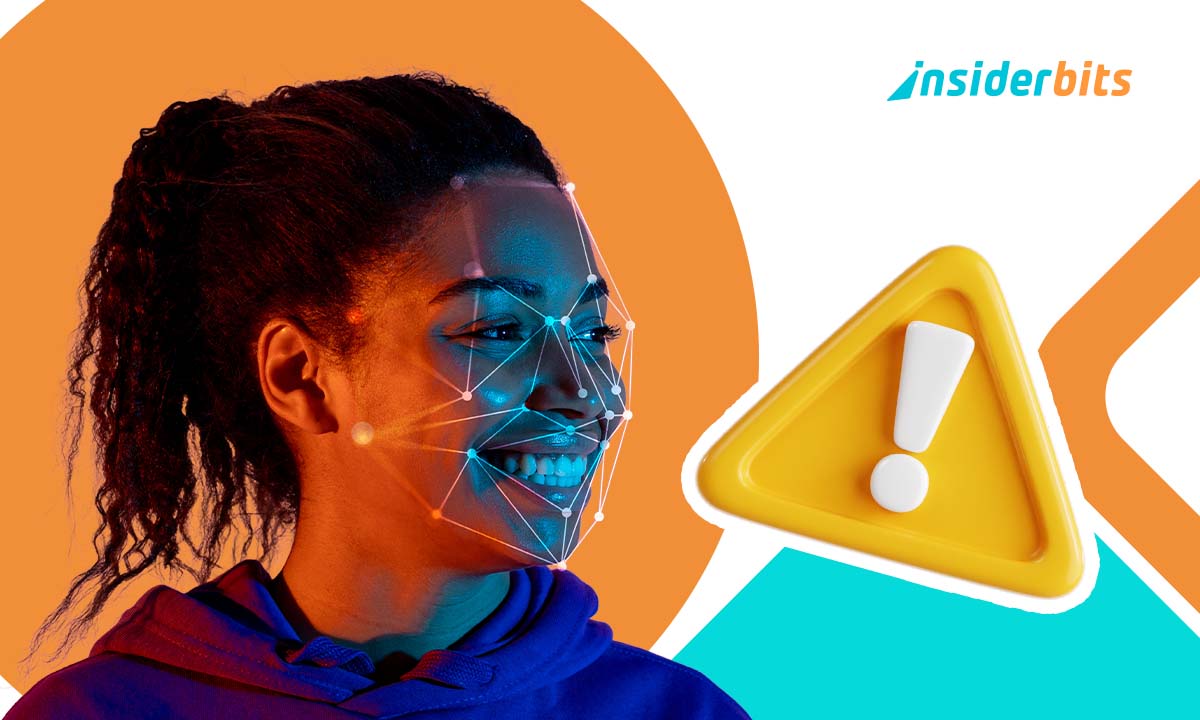Seeing isn’t always believing anymore. Videos and images can be altered with deepfakes, making it harder to distinguish truth from AI-generated deception in everyday content.
Some manipulations are harmless, but others spread misinformation, create false narratives, and damage reputations. Learning how they work is essential to recognizing suspicious media.
This guide by Insiderbits uncovers the risks, real-world impact, and ways to identify digital fakes. Read on to stay informed and understand how to protect yourself from deceptive content.
Correlato: DeepSeek AI: cos'è e come funziona
The Growing Threat of Deepfakes & Voice Cloning

AI is changing how we see and hear information online. With just a few clicks, anyone can create fake videos or clone voices that sound real.
Voice cloning lets scammers impersonate people in phone calls, tricking victims into giving away personal details. Fake videos, on the other hand, spread false information quickly.
Deepfakes are being used in scams, politics, and even celebrity hoaxes. As these tools become more advanced, it’s getting harder to tell what’s real from fake.
With AI improving every day, spotting fake media is becoming more difficult. To stay safe, people need to understand how these technologies work and their risks.
Why AI-Generated Content is Becoming Harder to Detect
AI now creates videos and voice recordings that look and sound just like real people. The small mistakes that once gave fakes away are disappearing.
New deepfake technology learns from detection tools and keeps improving. Every time a fake is spotted, AI adjusts to make the next one even harder to catch.
Deepfakes have become so realistic that even experts struggle to identify them. As this technology advances, verifying online content is turning into a major challenge.
The Role of Social Media in Amplifying Deepfakes
Social media makes it easy for deepfake videos and audio clips to spread. Misinformation can go viral before fact-checkers even have a chance to respond.
People often share shocking videos without checking if they’re real. Social media platforms prioritize engagement, sometimes pushing fake content ahead of verified information.
Deepfakes can quickly influence opinions by spreading false claims. If people believe what they see without questioning it, trust in real news and facts weakens.
How AI-Generated Media Is Fooling Millions
Deepfake technology fools people by using algorithms to replicate real human features. AI studies facial movements and voice patterns, making the fake media look and sound authentic.
One method is Generative Adversarial Networks. These systems generate fake images or voices, while refining them. Over time, the generator improves until the fake is nearly perfect.
Deepfakes exploit human trust in visual and audio cues. When people see a familiar face or hear a known voice, they instinctively believe it, even when subtle inconsistencies exist.
AI enhances realism by adding natural blinking, emotional nuances, and more. The result? A video or audio clip so convincing that even experts need special tools to detect manipulation.
The Most Alarming Real-Life Cases of AI Manipulation

AI-driven deception has moved into real-world crime. Scammers and political operatives now use synthetic media to manipulate, deceive, and exploit unsuspecting victims worldwide.
High-profile cases have shown how criminals use AI to clone voices, create fake endorsements, and manipulate elections. The impact is growing, and the damage is skyrocketing.
Deepfakes have played a role from executives tricked into transferring funds to politicians falsely portrayed in damaging videos, highlighting the urgent need for better detection tools.
Deepfake CEOs: How Criminals Are Stealing Millions
In February 2024, a Hong Kong-based finance executive transferred $25 million after scammers used AI-generated video calls to impersonate his company’s chief in a fake meeting.
A March 2025 scam in Georgia used deepfake executives to deceive over 6,000 people, leading to a £27 million ($35 million) fraud operation exposed by authorities.
Political Disinformation: AI’s Role in Election Manipulation
A March 2022 deepfake video of Ukraine’s President Volodymyr Zelenskyy falsely instructed troops to surrender. The fake was aired on Ukrainian media before being debunked.
In September 2024, deepfakes were used in a U.S. election scam, with an AI-generated Biden voice urging voters to stay home, leading to a $6 million fine.
Fake Celebrity Endorsements: The Dark Side of AI in Marketing
In October 2023, AI-generated ads misused Tom Hanks’ likeness without his consent, falsely endorsing a dental plan, misleading consumers, and prompting legal action.
A November 2024 case involved an AI deepfake of MrBeast promoting fraudulent giveaways, tricking fans into sending money, forcing the YouTuber to issue multiple warnings.
The Growing Threat of Voice Cloning in Phishing Attacks
An October 2024 scam targeted a Florida politician’s father, cloning his son’s voice to stage a fake emergency and demand $35,000 in ransom.
Deepfakes in voice cloning also contributed to a March 2025 scam in India, where fraudsters used AI-generated voices to manipulate digital payment users, causing major financial losses.
Correlato: AI Crime Predictors: How Technology Is Transforming Law Enforcement in 2025
How to Detect & Protect Yourself from AI Scams

AI-generated scams are getting harder to recognize, with fake voices and videos becoming more lifelike. Staying aware of these evolving threats is the first step to protection.
Many scams rely on urgency, pressuring victims to act fast before questioning what they see or hear. Recognizing these tactics can prevent costly mistakes.
Deepfakes and AI-powered fraud aren’t going away, but learning how to spot warning signs can reduce the risk of falling for these deceptive schemes.
Key Signs to Identify a Deepfake Video or Voice
- Facial Movements Look Off: blinking patterns, lip-sync issues, or stiff expressions may indicate AI manipulation since real human movements are naturally fluid;
- Lighting and Shadows Don’t Match: if shadows appear in the wrong direction or lighting shifts unnaturally, the video may be digitally altered;
- Voices Sound Robotic: AI-generated voices often lack natural breathing, emotional shifts, or proper pronunciation, making them sound unnatural upon close listening;
- Glitches and Distortions Appear: blurred edges, flickering artifacts, or face distortions are common flaws in deepfakes, revealing their artificial nature;
- Eye Movements Look Strange: AI struggles with natural eye behavior, often making subjects stare too long or blink unnaturally, exposing the video as fake;
- Lip Sync Is Off: if speech doesn’t perfectly match lip movements or background noise sounds artificial, the clip is likely AI-generated.
AI Tools That Help Detect Fake Media
With scams on the rise, detection tools have become essential for identifying manipulated content. These platforms analyze images, videos, and voices to uncover signs of tampering.
Deepware is a free tool designed to detect deepfake videos. It scans uploaded footage for signs of AI manipulation, such as unnatural facial movements or inconsistencies in lighting.
Resemble AI focuses on voice authentication, helping detect deepfakes. It analyzes speech patterns and pitch variations to identify whether a recording has been artificially generated.
These tools are crucial in fighting misinformation and fraud. As deepfake technology improves, AI detection methods must evolve to help users stay ahead of digital deception.
Best Practices to Safeguard Against AI-Driven Fraud
- Verify Sources First: always check the original source of a video, audio, or message before trusting it, especially if it makes bold claims;
- Question Urgent Requests: scammers pressure victims to act quickly. If someone demands money or sensitive info urgently, take a step back and verify;
- Use AI Detection Tools: various tools can analyze media and flag potential deepfakes, helping you identify manipulated content before falling for a scam;
- Enable Multi-Factor Authentication: adding extra security layers, like MFA, prevents scammers from accessing accounts even if they steal passwords or personal details;
- Stay Informed About AI Scams: fraud tactics evolve fast. Keeping up with the latest scams can help you recognize warning signs before becoming a target;
- Educate Friends and Family: scammers often target less tech-savvy individuals. Sharing knowledge about AI fraud helps others avoid falling for deceptive schemes.
Will Regulations Stop the Spread of Fake AI Content?

AI-generated misinformation is spreading fast, raising concerns about fraud and privacy. Governments are debating how to regulate synthetic media without restricting advancements.
Some countries have introduced laws against AI-generated deception, but enforcement remains difficult. As deepfake technology evolves, regulators struggle to keep up with emerging threats.
Deepfakes are already used for scams, political interference, and impersonation. Without stronger regulations and enforcement, digital deception could become even harder to control.
Government Actions Against AI-Generated Fraud
The U.S. Federal Trade Commission (FTC) launched a crackdown on deceptive AI practices in September 2024, targeting businesses that misuse artificial intelligence for fraud.
A proposed No AI Fraud Act introduced in 2024 aims to criminalize the use of AI in creating misleading content, reflecting growing legal efforts to address AI-driven scams.
Europol’s 2025 report highlights how deepfakes and AI-enhanced scams are fueling organized crime, urging countries to implement stronger policies against AI-related fraud.
How Social Media Platforms Are Fighting Deepfakes
In March 2025, Meta expanded its deepfake detection efforts ahead of Australia’s elections, rolling out fact-checking programs and warning labels for manipulated content.
X has also updated its policies to identify and label AI-altered videos. Some content is removed if deemed harmful, but enforcement remains inconsistent.
Despite these efforts, deepfakes continue to spread across platforms. Many users still struggle to differentiate real content from manipulated media, raising concerns about misinformation.
Ethical AI Development: Where to Draw the Line?
The AI Disclosure Act of 2023 proposes that AI-generated content should be clearly labeled, ensuring transparency and helping people distinguish real media from synthetic material.
California’s latest regulations require social media platforms to offer reporting tools for AI-generated impersonations, tackling the misuse of deepfake technology in identity fraud.
Ethical AI development is now a major focus, with lawmakers and companies balancing innovation with the need to prevent deepfakes from being exploited for deception.
Correlato: Securing Your Digital Life: Top Cybersecurity Apps for 2025
Awareness and Action Are Key to Stopping AI Fraud
AI-driven deception is becoming more advanced, but recognizing the signs and using the right tools can help you stay ahead of misinformation and fraud.
At Insiderbits, we explored the risks of deepfakes and AI scams, highlighting how awareness and detection technology can help protect digital trust in an evolving landscape.
Want to stay informed on the latest in technology, security, and AI? Then keep browsing Insiderbits for more insights on navigating the digital world safely.





